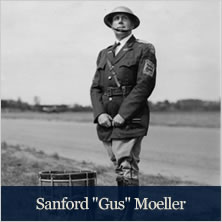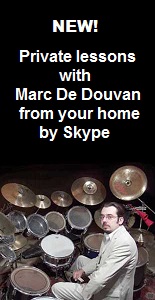
 : : Great drummers
: : Great drummers
- Acuña Alex
- Agostini Dante
- Alexander Tim "Herb"
- Allen Tony
- Ameen Robby
- Appice Carmine
- Aronoff Kenny
- Arpino Thierry
- Barretto Ray
- Belleville Pierre
- Bellson Louie
- Bissonette Gregg
- Blackwell Ed
- Blaine Hal
- Blakey Art
- Bonham John
- Bozzio Terry
- Brown Carlinhos
- Brown Gerry
- Bruford Bill
- Carrington Terri Lyne
- Ceccarelli André
- Cerrone Marc
- Chambers Dennis
- Cinelu Mino
- Clarke Kenny
- Cobham Billy
- Colaiuta Vinnie
- Collins Phil
- Conte Luis
- Copeland Stewart
- Da Fonseca Duduka
- de Grasso Jimmy
- de Johnette Jack
- Diabaté Inza
- Diaz Miguel "Anga"
- Dodds Warren "Baby"
- Donati Virgil
- Dunbar Lowell “Sly”
- Erbetta Marc
- Erskine Peter
- Escovedo Sheila "E"
- Ewandé Louis César
- Fanfant Jean-Philippe
- Foster Al
- Gadd Steve
- Garibaldi David
- Gastaldin Claude
- Gonzalez Jerry
- Gozzo Alain
- Greer Sonny
- Grohl Dave
- Guem
- Gurtu Trilok
- Gustke Ralf
- Hakim Omar
- Haynes Roy
- Hernandez “El Negro” Horacio
- Hidalgo Giovanni
- Higgins Billy
- Hoglan Gene
- Humair Daniel
- Hussain Zakir
- Jacquin Jean-Christophe
- Jimbo Akira
- Jones Elvin
- Jones "Philly" Joe
- Jones « Papa » Jo
- Jordison Joey
- Katché Manu
- Keita Mamady
- Kolinka Richard
- Krupa Gene
- Lake JR Oliver Gene
- Lang Thomas
- Latham Rick
- Mac Brain Nicko
- Mason Harvey
- Mattalia Alessia
- Mayer Jojo
- Michelino Silvano
- Minnemann Marco
- Mitchell John "Mitch"
- Mocidade Independente de Padre Miguel
- Moeller Sanford
- Moreira Airto
- Morello Joe
- N'Diaye Rose Doudou
- Oxley Tony
- Paice Ian
- Paolini Jean-Claude
- Parker Leon
- Peart Neil
- Phillips Simon
- Poleo Orlando
- Porcaro Jeff
- Portnoy Mike
- Pozo Chano
- Priester Aquiles
- Puente Ernesto « Tito »
- Purdie Bernard "Pretty"
- Quintana Jose Luis "Changuito"
- Rekow Raul
- Renaudin Bertrand
- Rich Buddy
- Roach Max
- Roddy Derek
- Samba Mokhtar
- Sanchez Poncho
- Santamaria Mongo
- Séry Paco
- Smith Chad
- Smith Marvin “Smitty”
- Smith Steve
- Sorum Matt
- Starr Ringo
- Stewart Bill
- Stubblefield Clyde
- Temiz Okay
- Terrana Mike
- Top Secret Drum Corps Basel Suisse
- Ulrich Lars
- Vander Christian
- Wassy Brice
- Watts Charlie
- Watts Jeff
- Webb Chick
- Weckl Dave
- White Lenny
- Wilk Brad
- Williams Tony
- Ziad Karim
Moeller Sanford
Musicians or bands:
Lancraft Fife and Drum Corps, George M. Cohen, Metropolitan opera house, the Seventh Regimental Army Band
Biography and commentary:

Born in 1886 and died in 1960, Sanford Moeller is one of the first educationalist to describe not only the rudiments of military drumming, by written music (the first score published for the US military drums dating from 1812, written by the Drum Major of the Marines, Charles Stewart Ashworth, with the use of typical American rudiments), but also specific playing techniques, often forgotten in symphony orchestra (traditional oral transmission of military drumming). His method, "The Moeller Book: The Art of Snare Drumming" was published in 1925 (6 years before the formalization of the 26 US rudiments of the "National Association of Rudimental Drummers" (NARD) of which George Lawrence Stone, author of the famous snare drum method "Stick Control for the Snare Drummer" (1935), was President). In addition to special rudiments like "flams taps" (a specialty of Steve Gadd), "flams paradiddles" etc., which, by the use of triple or quadruple stroke of the same hand, are distinguished from the tradition of European military drumming (in France other rudiments exist, called "coups de baguette" (“stick strokes”) originally, like the "coup de charge" (“charge stroke”), the "flagada" or the "pataflafla"*), Sanford is known for his famous "Moeller technique” or "Moeller Stroke". This technique actually quite natural, was inspired to him by the observation of drummers from the US Army, veterans of the Civil War, who could play whole days without tiring (the drum, at a time where guns fired only one shot (see also "Batteries of the First Empire" *), was essential for the organization of the rows of infantry, their marching, receiving orders and even recognize their regiment or nationality by ear!). A good example where the theory follows the practice and not the reverse (So Sanford Moeller is not the inventor of this technique, as many think, but the first writer to describe it by writing and teaching it to jazzmen, "modern" drummers). I have used myself the Moeller technique for years without knowing it (by playing five hours in a row at carnivals, the basic technique of the "Caixa", the Brazilian snare drum, being to play the rhythms by accents on a continuous ghost notes carpet in sixteenth notes single stroke roll, on the model of the djembe). The idea is to use the rebound and alternating strokes by following what he calls " Up stroke" and "Down stroke", that is to say, a stroke starting from below (soft, ghost note ) and bouncing up and a stroke starting from above (strong, accent) and bouncing down (see my lesson, "Hits alternating", which shows that it is actually to alternate the hit and preparation of different parts of the limbs (hitting with the wrist (soft strokes) and arm (strong strokes), for example, which can be extrapolated to the leg, commonly called "heel-toe", a technique first used in jazz samba/bossa nova drumset drumming, to put an accent on the second stroke of a shuffle and imitate the surdo)). Moeller was the teacher of the most brilliant drumset drummers of the generation that followed, like Gene Krupa and Jim Chapin, the first author of jazz bebop drumset method ("Advanced Techniques for the Modern Drummer", 1948), observed in New York from Kenny Clarke mainly, his inventor, but also Max Roach and Art Blakey, all drummers of Dizzy Gillespie and Charlie Parker in the 1940s. Besides, Gene Krupa explains the Moeller technique using very detailed photos (like myself on this website, lesson "Hits alternating") in his own method from 1938 ("Drum Method"), the first method presenting the concept of independence of the 4 limbs (playing with chords or not, which deviates from drum alone or Dixieland style with rolls on snare drum, bell or wood-block, described in a method of Ray Bauduc 1937), and which is still a seeked reference to learn the drumset, especially in the USA, demonstrating its extraordinary avant gardism.
* See the official "Méthode de tambour et caisse claire d'orchestre" (“Military drum and orchestra snare drum Method") of the Conservatoire National Supérieur de Musique de Paris (“National Higher Conservatory of Music in Paris”) written by Robert Tourte (Publication: 1946), transcribing also all Napoleonic "batteries (which designated here compositions only for military drums, from the expression “battre le tambour” ("beat the drum")) of the First Empire " (in addition to the "Marches de la Garde Républicaine" ("Marches of the Republican Guard ", still in use) and French rudiments). The French rudiments are called "coups de baguette" (“stick strokes”), which is a confusing name because a stick stroke is also a way to strike the instrument, not a composition (example: “double stroke roll"), but synonymy with the American word (which is morover of French origin!) "rudiments" leaves no doubt (= rudimentary phrases, for learning, and combined in the compositions, some being the same, although that once again designated differently in the two languages, as the “moulin” ("mill") translated in " single paradiddle", or the “volant” ("wheel") in "double paradiddle"). The French rudiments come from an ancient tradition perhaps Turkish (which brought snare and bass drums (“cases”: “caisses”), timpani and cymbals and their military use (Janissary)) and also Swiss (integration of Swiss battalions and the drum in the French army after at the battle of Marignan, 1515). They aroused many years of technical research in France (very ancient scores sometimes for instructors of the army exist (in 1588 for the oldest "Orchésographie" from Thoinot Arbeau, or "Instruction for the drums", 1754), and they sometimes use still other rudiments, often named by onomatopoeia (already evoking the "scat" and "human beatbox", but also the old Indian "bols", yet different) for the oral transmission (see the "Percussions" magazine No. 29 (December 2010) of the “Association Française pour la Percussion” (“French Association for Percussion”))!). The French "rudiments" were probably standardized in the Napoleonic era (apogee of formations in rows of infantry, creating an unmatched virtuosity thereafter, before the gun can fire several shots without reloading, and electric telecommunications, making the drum obsolete on the battlefield). The French rudiments in turn certainly inspired some US officials rudiments of the NARD, but it is a fact that all are not yet taken today (although recent additions have been made as the "pataflafla", named as in France, by the Percussive Arts Society, this time, coming off the functionality and military tradition, defining 40 different rudiments, in 1984). So, US rudiments do not appear as an "update" making useless the knowing of the French traditional Napoleonic "stick strokes", moreover often more rudimentary and logical (Descartes is not far), but well as a specific cultural approach (be aware that a mere rudiment could be associated with and reserved for an order, a regiment or a nationality in the army, as an uniform or a flag). I remind that the War of Independence of the United States of America (1775-1783) was made alongside French regiments and shortly before (1763, English conquest during the "7 years' War") a Much of the current United States was still composed of French colonies ("New France"), not just the current Louisiana (sale of the last colonies by Napoleon Bonaparte in 1803), also the cradle of jazz (the "coup coulé" ("slipped stroke") is a specific French rudiment, also typical of New Orleans jazz and its Mardi gras "marching bands" (coming from a Catholic French colonies tradition), that puts a ternary syncopated accent probably the most typical of jazz in a ra of 4 strokes ("mixed sticks", expression attested by a French dictionary since 1690), but not present in the rudiments of the N.A.R.D. or even the P.A.S.). All of this makes me think that a drummer who says himself really progressive and modern should know the French rudiments as described on my website and in my methods or the Robert Tourte method. It should be noticed that the use of the accent in the French military batteries already asked to master the Moeller technique. Moreover, Robert Tourte clearly indicates in his method: "The forearms and wrists only, must act" while not specifying how. This suggests that Sanford Moeller is well the first writer in the world to precisely describe the concept that I call "hits alternating". Finally, some US rudiments are not so basic because sometimes little efficient (triple or quadruple strokes of the same hand in succession, probably for the sake of showing virtuosity and national particularism), so I don't recommend them for beginners in modern drumset.
Marc De Douvan, publication in French: March 3, 2009 (for the translation in English: July 12, 2015)
Link to Drummerworld or other
See© 2005 Marc de Douvan Crédits Mentions légales
